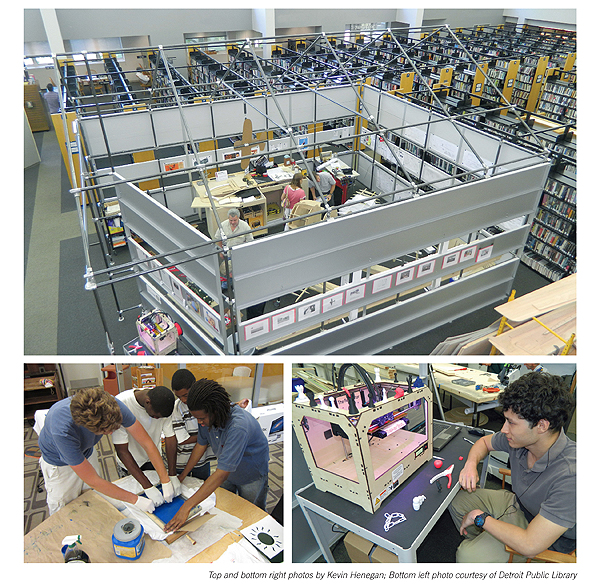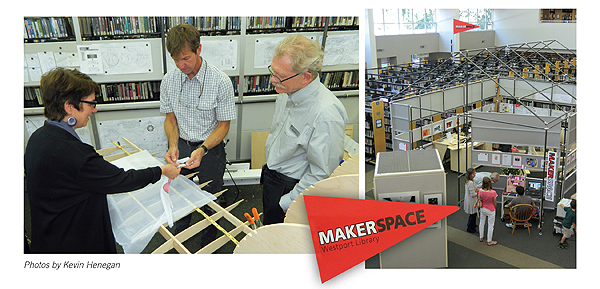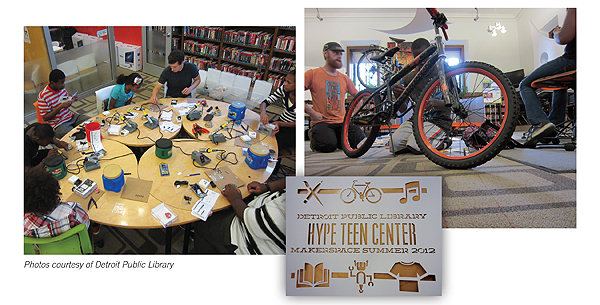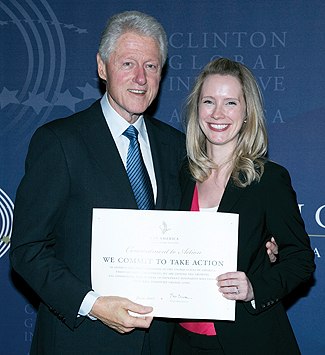
The Makings of
Maker Spaces
-
Part 1 — Space for Creation, Not Just Consumption
-
Part 2 — Espress Yourself
-
Part 3 — A Fabulous Home for Cocreation
Maker spaces in libraries are the latest step in the evolving debate over what public libraries’ core mission is or should be. From collecting in an era of scarce resources to curation in an era of overabundant ones, some libraries are moving to incorporate cocreation: providing the tools to help patrons produce their own works of art or information and sometimes also collecting the results to share with other members of the community.
Maker spaces promote learning through play; have the potential to demystify science, math, technology, and engineering; and encourage women and underrepresented minorities to seek careers in those fields.
They also tie in to the growing trend of indie artists in every medium—including books—who are bypassing traditional gatekeepers, taking advantage of new tools to produce professionally polished products, and going direct to the web to seek an audience.
Maker spaces also acknowledge green concerns by reconnecting consumers to the labor involved in producing what they use. While 3-D printers are perhaps the signature offering of Maker spaces, libraries find that low-tech and low-cost opportunities are just as popular.
Making Space for Creation, Not Just Consumption
Libraries around the United States offer tools for patrons to learn by doing
By Lauren Britton
Join us for the
LJ Tech Summit
An Online Event
November 14, 2012
11:00 am – 4:00 pm EST
Discover the tools you need to make the latest technology systems work for your library!
Register today!
On a Saturday afternoon last winter, two young boys came into the Fayetteville Free Library, NY, with their design of the “public library of the future.” I had the opportunity to watch how delighted they were as their model took physical form on our MakerBot 3-D printer, a tangible example of knowledge creation now possible in libraries thanks to Maker spaces.
A Maker space refers to people coming together to create and share resources, knowledge, and “stuff.” There are a number of freestanding and school-based Maker spaces nationwide, and several forward-thinking libraries have started developing them for their communities.
Incorporating Maker spaces into library service can have a life-altering impact on community members, who then have the tools, access, and training necessary to tinker with and remake their world. Just as libraries are reflections of their patrons, Maker spaces can reflect the needs and desires of the local residents. Typically, the spaces will:
- Foster play and exploration
- Facilitate informal learning opportunities
- Nurture peer-to-peer training
- Work with community members as true partners, not as users or patrons
- Develop a culture of creating as opposed to consuming.
No tools required
The beauty of the Maker movement, particularly in the library, is that there is no set list of equipment or programming required to make a space successful. There are some tools and technology typically associated with Maker spaces, like 3-D printers, but they are not required. However, the list of equipment and materials will naturally grow as specific projects and programs generate new needs. For example, a library Maker experience might be based on costume-making that would require sewing machines, whereas a graphic design workshop would benefit from access to a vinyl cutter.
Maker spaces support learning in an informal, play-focused environment that can cultivate an interest in science, technology, and design. Scott Nicholson, associate professor in the School of Information Studies at Syracuse University, NY, writes in Strategies for Meaningful Gamification: Concepts Behind Transformative Play and Participatory Museums (a presentation at the Meaningful Play conference in Lansing, MI):
Someone who wants to do something because it is fun is more likely to find an activity to be meaningful than someone who is doing something for a reward or to learn something. When someone is engaged in a playful space, that person will learn more easily. Creating playful information-based spaces allows the learner to explore and engage with content on the learner’s terms instead of on the instructor’s terms.
Maker spaces can also empower youth through the peer-to-peer training opportunities that organically develop in these play-based spaces. Neil Gershenfeld, director of MIT’s Center for Bits and Atoms and author of Fab: The Coming Revolution on Your Desktop—from Personal Computers to Personal Fabrication, discovered that learning in these spaces is often driven by the demand for knowledge, as opposed to the supply of knowledge.
“The biggest impediment to personal fabrication is not technical; it’s already possible to effectively do it,” Gershenfeld writes. “And it’s not training; the just-in-time peer-to-peer model works as well in the field as at MIT. Rather, the biggest limitation is simply the lack of knowledge that this is even possible.”
Role of the community
Community members are at the heart of any Maker space, regardless of its location. Incorporating Maker spaces into library service can create transformative experiences for those individuals. For example, someone can learn how to fix a blender by designing and then 3-D printing the broken part. Another person may learn to write code or build a robot. People learn from one another by sharing knowledge and tools.
Maker space—or, more specifically, the act of making—encourages and gives people permission to tinker, hack, remake, and perhaps even change society.
“Making anything for yourself is a political act,” says Zeke Leonard, assistant professor, Syracuse University School of Design. “The further we get from the creation of an object, the less we have a connection with the people, resources, and process. This limits how we assign value to objects. If we can all start to make more and consume less, then we can be more thoughtful about the resources used to create the objects and food and garments that we fill our lives with,” Leonard says.
“Maybe the urge to make manifests in putting a patch on a worn pair of jeans instead of buying new ones. Maybe it manifests in having friends over for a ‘pot-luck’ instead of meeting at a restaurant, as sharing food you have made is an immediate joy that is a long-standing tradition,” Leonard says. “These seemingly trivial actions are actually making activism, they are a way in the modern world that we can have some control over our own surroundings that is not dictated by the limit on our credit card.”
So what does it mean for libraries to give our communities the tools, access, training, and permission to make, hack, and tinker instead of simply consume? MIT’s Gershenfeld expresses it best: “Instead of trying to interest kids in science as received knowledge, it’s possible to equip them to do science, giving them both the knowledge and the tools to discover it. Instead of building better bombs, emerging technology can help build better communities.” Library Maker spaces give everyone the opportunity to see the world around them differently, to explore and imagine new possibilities for a future they help create.

A CENTER OF PRODUCTION Wesport PL Director Maxine Bleiweis (l.) confers with Maker-in-Residence Joseph Schott (c.) and Assistant Director for Innovation and User Experience Bill Derry on fabric choices for one of two wooden model planes that are being produced in the library’s Maker Space (rt. photo).
Westport’s Makers in residence
There are several libraries across the United States experimenting with Maker spaces, each library using different ideas and concepts to manage them. The Westport Public Library (WPL), CT, launched its Maker space in July.
Maxine Bleiweis, the library’s director, said when the Maker space opened that while early adoption is a risk, she believes that the Westport community is usually ahead of the curve. The library’s one-day Mini Maker Faire in April attracted 2200 visitors who came to see exhibits including a demonstration of a Body Sound Suit, how-to instructional sessions on topics such as using Google SketchUp to create a 3-D model, and presentations like the talk by New York Times tech writer David Pogue.
“No longer is it normal to go to college, graduate, interview, and be taken on by a big company. We are instead looking to ourselves and saying, What can we think of? What can we create?” Bleiweis says, explaining that part of the goal of the new space will be to foster a spirit of entrepreneurship within the community.
“We want the library to be a space where you can invent. You can learn at every stage of your life,” says Bleiweis. WPL now has a Maker-in-Residence who was interested in building large, wooden model airplanes. The library used these airplanes and the concept of flight as a metaphor for imagination.
WPL also purchased a MakerBot Replicator, which is a 3-D printer. A few excited teenagers became the curators of the bot and help patrons design and print projects. Bleiweis says that, in true Maker fashion, the library doesn’t know where it’s going next with its Maker space. They are allowing the space to evolve naturally. When people ask her what she is doing next, her response is, “What do you think we should do next?” Then the library works with the community to make it happen.
Bleiweis says the library is there to provide the framework, not to be in charge. She says there is a shift from a librarian being the person who had all of the answers to the person who has questions and the ability to find the answers.

BELIEVE THE H.Y.P.E Detroit Public Library’s Maker space initiative, called H.Y.P.E. Teen Center (inset), exposes teens
to new activities and demystifies topics such as electronics (l.) and bike repair.
Creative teens in Detroit
The H.Y.P.E. Teen Center at the Detroit Public Library (DPL) is another library Maker space example. Steve Teeri, the customer support assistant at H.Y.P.E, partnered with Jeff Sturges, founder of the Mt. Elliot Maker space (also in Detroit), to develop a library Maker space concept for DPL. They received a grant from Cognizant, a New York–based IT company, to purchase some equipment and start programming.
They started the space with six soldering irons, a digital vinyl cutter, bike repair toolkits, a wireless color printer, and eight Arduino kits. Arduino is an open source electronic prototyping platform for the creation of interactive electronic objects. This past summer, the library ran weekly Maker day camps that included Arduino robotics, a bike tech camp, and a clothing design and sewing camp.
Each of the programs was taught by a local expert paid through grant funding. Although it is valuable for a library to have community members volunteer their time and expertise, it is questionable whether programs based solely on volunteers will be sustainable in the long term.
Teeri says that the mission of libraries is to promote learning and that using Maker spaces to foster interest in STEM (science, technology, engineering, and math) learning goes a long way.
“We’ve had a large number of teens come into the library and get involved. [Maker spaces] make these higher-level learning concepts more accessible,” Teeri says. “A lot of the workshops being done in library Maker spaces help to remove some of the fear associated with terms like engineering, math, and robotics.”

IN GOOD COMPANY Author Britton, here with President Clinton, took part in a Maker Education Initiative through the Clinton Global Initiative. Photo by Paul Morse/Clinton Global Initiative,
CGI America 2012 WJC Photo Line
The Clinton Global Initiative
Individual libraries are not the only organizations to recognize the potential impact that Maker spaces can have on their community. The Clinton Global Initiative: America (CGI), an annual event focused on finding solutions that promote economic recovery in the United States, included a Maker subgroup in its STEM Learning Working Group. I had the opportunity to join with representatives from organizations including Girl Scouts of America, Cognizant, Maker Education Initiative, Science Club for Girls, and the Society of Women Engineers to develop student-centered approaches to learning though the Maker Movement, providing innovative ways for getting young people excited about STEM.
The Maker Education Initiative (which launched in May and is sponsored by Cognizant, Intel, O’Reilly Media, and Pixar Animation Studios) is developing a Maker Corps to spark an interest in STEM and the arts by giving every child the opportunity to become a Maker.
Maker Corps, as announced at CGI on June 8, will “recruit and prepare college students to serve as mentors and peers in a variety of community settings, which will also provide valuable full-time jobs in the summer and part-time jobs during the school year. Maker Corps members will be trained to engage children in creative projects that develop problem-solving skills in ways that make science and technology fun,” according to a press release from the Maker Education Initiative. Libraries may use Maker Corps to provide additional support for their Maker spaces.
IMLS and Maker culture
The Institute for Museum and Library Services (IMLS) also supports making initiatives in library spaces.
“Libraries are able to adopt new approaches and use incredible creativity in engaging community members in new ways, becoming fertile spaces for making activities,” says Susan Hildreth, director of IMLS. “We need to leverage what we know about learning and our trusted role as learning places to help prepare our visitors for success in today’s digital world. Maker culture is one way for libraries to support innovation and creativity, using library space in ways that people both want and need. The IMLS stands ready to support libraries in this way.”
Maker spaces provide libraries with an opportunity to re-imagine how they engage with community members.
R. David Lankes, professor and dean’s scholar for New Librarianship at Syracuse University, writes in The Atlas of New Leadership, “Librarianship is not about artifacts, it is about knowledge and facilitating knowledge creation. So what should we be spending our precious resources on? Knowledge creation tools, not the results of knowledge creation.”



Here it is the end of January. I read this article mid-October, 2012 and was super excited about the Espresso Book Machine pictured. I was more than deflated when I was finally quoted a price for the machine. It ranges between $85,000 to $90,000. and you must purchase a D110 printer to go with it and that was quoted at $25,000.00. Of course, there are more $’s with service contract, toner, etc. I work for a library in rural America and the cost of this printer is two times the amount of our maintenance budget for 3 buildings. How did Brooklyn afford to purchase this machine and the extras that go with it?